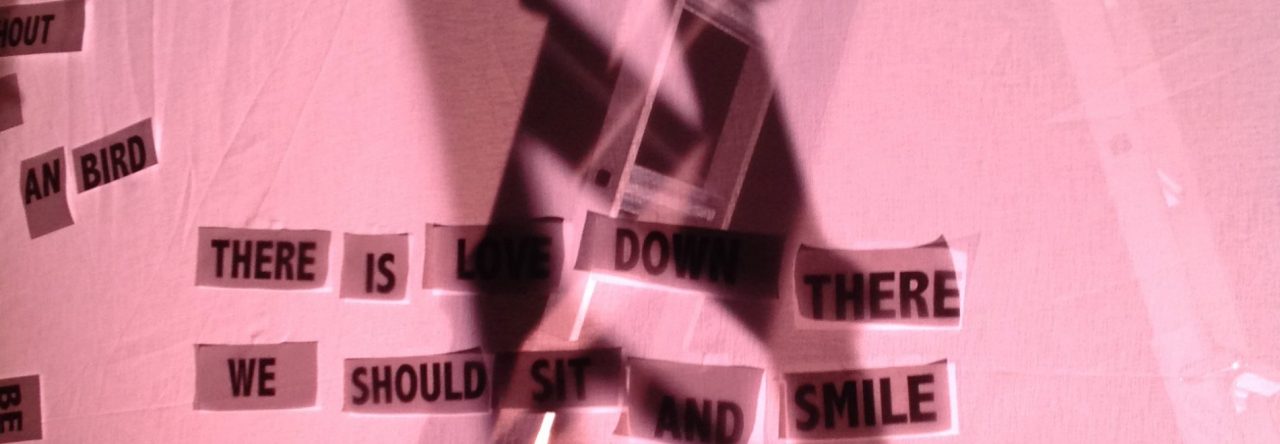I’ll be around
by Zack Faulks
The artists behind “I’ll be around” (Gabriella Hu, Ayana Madi, Julie Liu and Megan Lane) chose an old vinyl record player as their object. It evoked for me a sense of nostalgia and loss, as well as a sense of homecoming and welcoming.
The use of rhythm and duration was particularly interesting to me, as obviously inherent in a record player is musicality and rhythm. I loved the use of ambient noise in the opening of the piece. There was whistling and rustling the source of which was not clear. But as it ramped up, I began to feel a sense of urgency. The rhythm, such as it was, was one of continual increase, without logical endpoint. Then the record begins to spin, and a consistent sort of “whirr” is added. Which while giving me a more stable kind of anchor, still left me in anticipation of the music itself being played. It is only once the needle dropped, almost a minute and a half into the piece, that I was finally satisfied. The patience in the tempo and plotting of the piece is something very special. Building my anticipation and suspense around the drop of the needle transformed my understanding of the object, which I suppose was the objective. Making it more than a method of music delivery, it now becomes a way to bring order to the chaos and regulate the rhythm of the world.
The topography of the record was a strong choice as well. There was miniature furniture on it, chairs, that transformed it from a record to an interesting microcosm of the world. As the chaos swirled around it, the chairs stayed still, but as the record began to spin, they began to spin with it, and once the needle a really interesting moment occurred when it actually knocked one of the chairs over, shifting the sort of landscape they had created, and bringing with it a fascinating sort of consequence and cost to the music. An interaction of sorts between the musical and the physical established a tentative relationship between them.
The needle itself becomes the sort of make-shift protagonist of the scene, bobbing up and down at intervals that, while associated with an established rhythm, change fairly often. When it makes contact with the disk, footage of dancers, some old and some new, pops into view. When it is removed, the dancers disappear abrupt. This gave me the feeling of their being a secret, wondrous world contained in the disk and the music, which can only be released in short bursts, lest it alter what exists any further. It is careful, although not always successful, of not disrupting any more of the chairs.
The composition of the piece is a very interesting mix of practical elements, as well as things that were clearly added in post-production. The dancers, of course, were very clearly added in the editing, and are footage found by the group. But I am curious as to whether or not the ambient noises that became so loud at the beginning were diegetic or not. The same goes for the music. After some time listening and watching, I think I have found a moment at which the needle drops and the music do not quite line up, but I am not entirely certain. In anycase, the sound design is very impressive. The opening “whirr” becomes quite menacing, and the music is a lovely soothing break. The opening minute was very engaging the first time I saw this piece as well. Beginning with darkness allows for an enigmatic opener, and when the image does fade into view, it is not immediately clear, at least it wasn’t to me, that the chairs were on a record player. I had begun to assume that the group had chosen “chairs” as their object of choice, when suddenly they began to spin. It was very clever to have the needle out of frame, and have a shallow angle on the record so as to not give away the game too soon. I also appreciated that the dancers and the needle were on opposite sides, so that both were plainly visible without occluding each other.
My affective response to the piece was one almost of mourning, although perhaps not as morosely as that implies. The music only being able to exist for short spaces, in between the spinning chairs, gave me a sense of it being constrained and I felt myself yearning in sympathy with it. As well, the overlaying of multiple instances of dance footage, oftentimes at different playback speeds conveyed to me that something was perhaps being lost in translation. That maybe, because of the constraints, as much beauty was being compressed into a few seconds as it could manage. Ending the piece with the title though reassured me. The text “I’ll be around” indicated to me that the rhythm and music could continue, though it may be constrained.
My reflection on the piece has caused me to think about the very sporadic nature in which joy and creativity come to me in my life. The music, as it were. Things which make life worth living. Oftentimes, I schedule what makes me happy around more mundane tasks, which of course need to be done, as much as the needle attempts to make room for the chairs. Ultimately though, the chairs can be moved. The topography could have been arranged in a way that made space for the needle, as well as the chairs, or even prioritized the music. But I know that that is often not the way that I view life. That’s why this piece is particularly meaningful to me. Sometimes I need to hear that the music will be around again.
